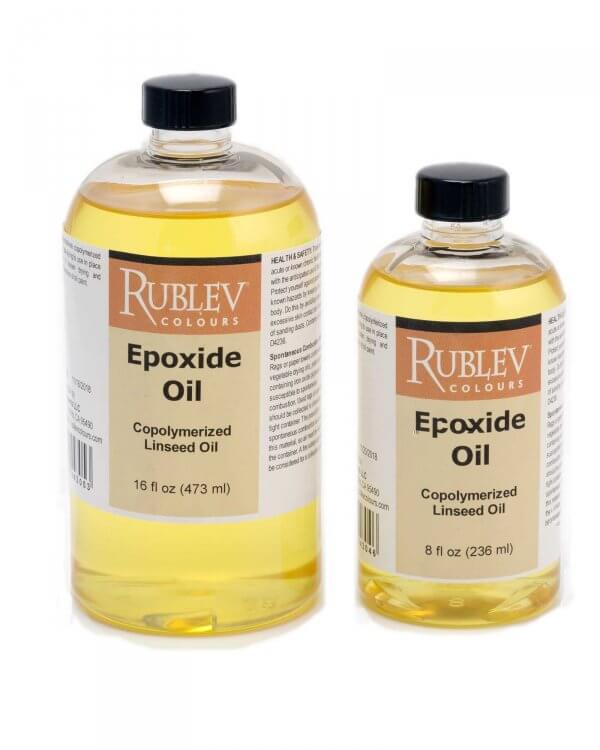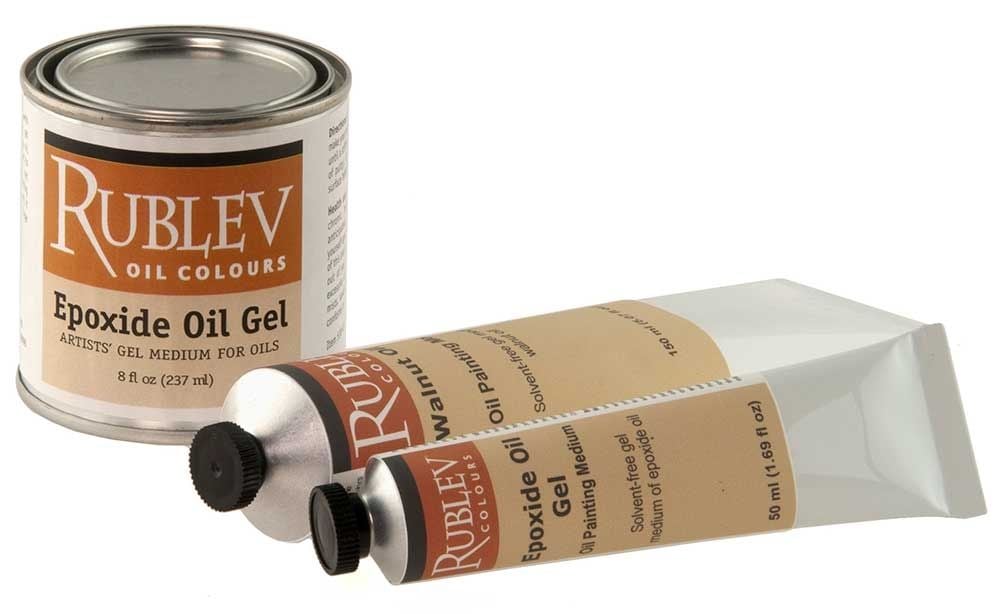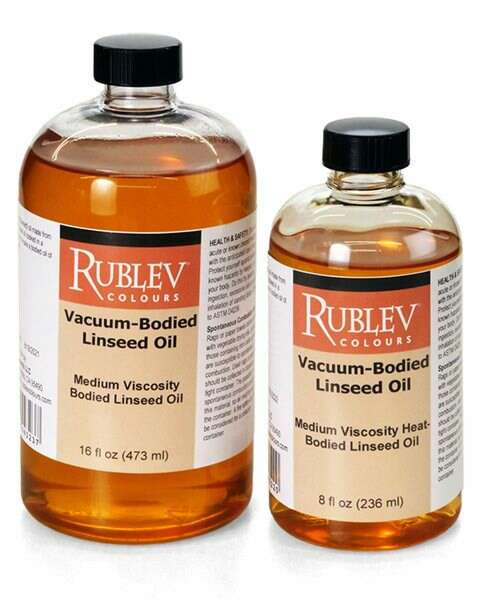
Or How to Reduce Yellowing in Oil Paint
There is no paint known that will keep its original color indefinitely. From the moment it is applied, it starts changing color. The only issue is, therefore, the degree to which this color change will take place.
The oils and resins used by artists tend to yellow or discolor upon drying and aging. Since oxidation and polymerization are the main actions during this process, we can more or less assume that the oxidized and polymerized molecules are darker in color than the original molecules, and these give yellowing or poor color retention.
Questions arise as to which of the aging processes have a greater effect on yellowing and what types of oils will tend to yellow more. The oils that tend to yellow more are oils that have large percentages of unsaturated fatty acids, while oils with high percentages of lower double bond acids yellow less.
| Fatty Acid Content* | Linseed Oil | Walnut Oil | Safflower Oil |
| Polyunsaturated α-linolenic acid | 53% | 5% | – |
| Polyunsaturated linoleic acid | 16% | 51% | 78% |
| Monounsaturated oleic acid | 21% | 28% | 13% |
| Saturated acids | 10% | 16% | 9% |
* These are approximate percentages of fatty acids that vary in different samples of oils.
Oils with less polyunsaturated fatty acids have less inherent yellow color (appear paler) and also yellow less. (Polyunsaturated fatty acids contain more than one double bond in the backbone of their molecular structure. The double bond is what gives drying oils their characteristic drying property.) For this reason, walnut oil is paler and yellows less than linseed oil, and safflower oil is paler and yellows less than walnut oil. On the other hand, oils with lower percentages of unsaturated fatty acids, especially linolenic acid, dry slower and tend to form less durable paint films. This is why linseed oil, although yellowing more than walnut oil, is used more often in oil painting.
One way to mitigate yellowing in oil painting is to substitute bodied or partially polymerized oils* (oils that have been heat-treated, for example) for untreated or unbodied oils. Since oxidation is the leading cause of yellowing, partially polymerized oils oxidize less to form a solid film than untreated oil, hence yellow less.
* Bodied oils are better known to artists as ‘stand oils.’ Stand oil is an antiquated term that today designates any oil that has been heat-treated, which is significantly different from how stand oils of the 18th and 19th centuries were processed when the Dutch first used the term.
Another way to improve non-yellowing is to promote drying by polymerization rather than oxidation through a chemical means. If we close up the double bonds so that a minimum of oxidation takes place, we improve the non-yellowing characteristics of the oil. Chemically processed oils, where the processing takes place at the double bond, tend to yellow less than unprocessed oils.
By an addition reaction at the double bonds and removing them from possible oxidation and yellowing, we can improve the color retention of the oil. In addition to improving color retention, this addition process improves its resistance to water and chemicals.
One such addition reaction is by adding cyclopentadiene to the oil molecule. The addition takes place at the double bond. Cyclopentadiene is added to the oil by heat bodying together with oil to obtain a combined polymer oil where the good properties of both improve the good properties of one. Upon addition to the oil at the double bonds, we actually form two cyclopentadiene rings, forming dicyclopentadiene.
Dicyclopentadiene is a byproduct of petroleum with the chemical formula C10H12. It is a white crystalline solid with a camphor-like odor at room temperature. Dicyclopentadiene is a monomer in polymerization reactions and finds major use with resins, particularly unsaturated polyester resins, and in inks, adhesives, and paints.
Dicyclopentadiene copolymerized oil shows improved drying and bodying characteristics. It has better water and chemical resistance than untreated oil. The brushing characteristics of the oil are superior to other oils.

Epoxide Oil
Natural Pigments introduces Epoxide Oil, a dicyclopentadiene copolymer linseed oil. It is a fast-drying oil. The copolymer of linseed oil and dicyclopentadiene provides a new vehicle that can be added to artists’ paints like stand oil or other bodied oils, yet is easier to brush. Use it in place of resinous mediums to speed up drying and improve film formation. Combine it with grinding oils when mulling pigments to make paint.

Epoxide Oil Gel
Epoxide Oil Gel is a thixotropic painting medium made with dicyclopentadiene copolymer linseed oil and pyrogenic silica. Epoxide Oil Gel is a translucent yellow gel that adds transparency and thixotropic body to oil, resin-oil, or alkyd paint. Add directly to your paint to give it transparency without thinning its consistency. Add pigments or extenders to thicken it to create impasto effects that do not sink in.
Questions and Answers about Epoxide Oil
Does Epoxide Oil yellow less than stand oil, equal to or less than?
The initial color of Epoxide Oil is the same or slightly darker than vacuum-bodied linseed oil (such as those offered by Natural Pigments), which is three on the Gardner Color scale. However, it yellows less or about the same as bodied oil and much less than untreated oil, such as refined or cold-pressed linseed oil.
What is the viscosity of Epoxide Oil? Is it like that of medium viscosity-bodied oil or more like raw oil?
The viscosity of the Epoxide Linseed Oil is Z3–Z4 on the Gardner-Holdt scale or 36–46 Stokes at 25° C., which is slightly heavier than Natural Pigments’ medium-viscosity bodied linseed oil.
Does Epoxide Oil dry faster than linseed oil? How much faster does it dry?
Epoxide Oil dries faster than most other oils, such as bodied, refined, or raw linseed oil. We do not yet have quantified data on the comparative drying characteristics of the oils offered by Natural Pigments, but it appears to dry faster than all the other oils, except for “boiled oil,” which contains driers.
Are there any negative side effects known when Epoxide Oil ages?
There are no known negative effects of Epoxide Oil. When dicyclopentadiene copolymerized oils were first developed, they exhibited increased viscosity upon aging. This defect has since been eliminated through better processing.
How does Epoxide Oil compare in glossiness to other bodied and unbodied oils?
It forms less glossy films than bodied oils but more than unbodied ones.
How does Epoxide Oil affect leveling or brush stroke retention?
It levels less than bodied oil and brushes out better with less drag than most bodied oils.
Can you describe what you mean by “bodying characteristics”? Do you mean more body as in holding impasto or brush strokes better?
No, it means it will polymerize more rapidly and at lower temperatures than untreated oils. However, it does have better brushing qualities (less drag and tackiness) than bodied oil.
What is its history of use in industry or in artistic painting?
Dicyclopentadiene copolymerized oils have been used in the coatings industry since the 1940s, and longer, if you consider earlier related development of such treated oils.
Can one use the usual solvents in the same ways with Epoxide Oil?
Yes, you can use any of the solvents used in oil painting with Epoxide Oil, such as turpentine, mineral spirits, and spike oil.
What are the recommended uses of Epoxide Oil?
Epoxide Oil is a good substitute for any drying oil containing driers because it dries fast, has better initial color, and yellows less.
It is a good substitute for untreated oils or resinous mediums when adding these to oil colors to improve paint consistency, drying, color retention, and film hardness.
Can Epoxide Oil be used as a component in paint medium, that is, can it be mixed with resins, balsams, and other oils?
Yes, it can be mixed and treated like any other vegetable drying oil.
Is the Epoxide Oil stronger than stand oil, and if so, can it be mixed with other drying oils, like poppy oil? Would the result be a paler oil but stronger and faster drying than poppy oil by itself?
Epoxide Oil has different qualities than those of bodied oils. For example, it is less leveling and forms a harder yet less glossy surface than bodied oils. You can mix it with other oils, such as walnut or poppy oil for specialized uses. We have used it in blends with refined linseed oil and walnut oil for some custom-made paints and mediums.
Try a starting recipe of 70% poppy or walnut oil and 30% Epoxide Oil. If this is too viscous, thin it with odorless mineral spirits or turpentine. Avoid the use of resins initially until you see how this oil behaves with your paint.
If you need something more thixotropic, try our thixotropic medium, Oleogel, a clear gel medium that has a small amount of “tooth.”
Can Epoxide Oil be used to make lead white paint?
Yes, you can use it to make lead white paint or any other oil color. We recommend a mixture of 30% Epoxide Oil and 70% linseed oil (such as Refined Aged Linseed Oil or Pale Grinders Linseed Oil), instead of using it by itself to make lead white.
You can also get interesting results if you mix a heavy or extra-heavy bodied linseed oil in a ratio of 20:80 with the Pale Grinders Linseed Oil when grinding lead white. The result will be an extra ropey but flowing lead white. Add some mineral spirits to reduce the viscosity.











